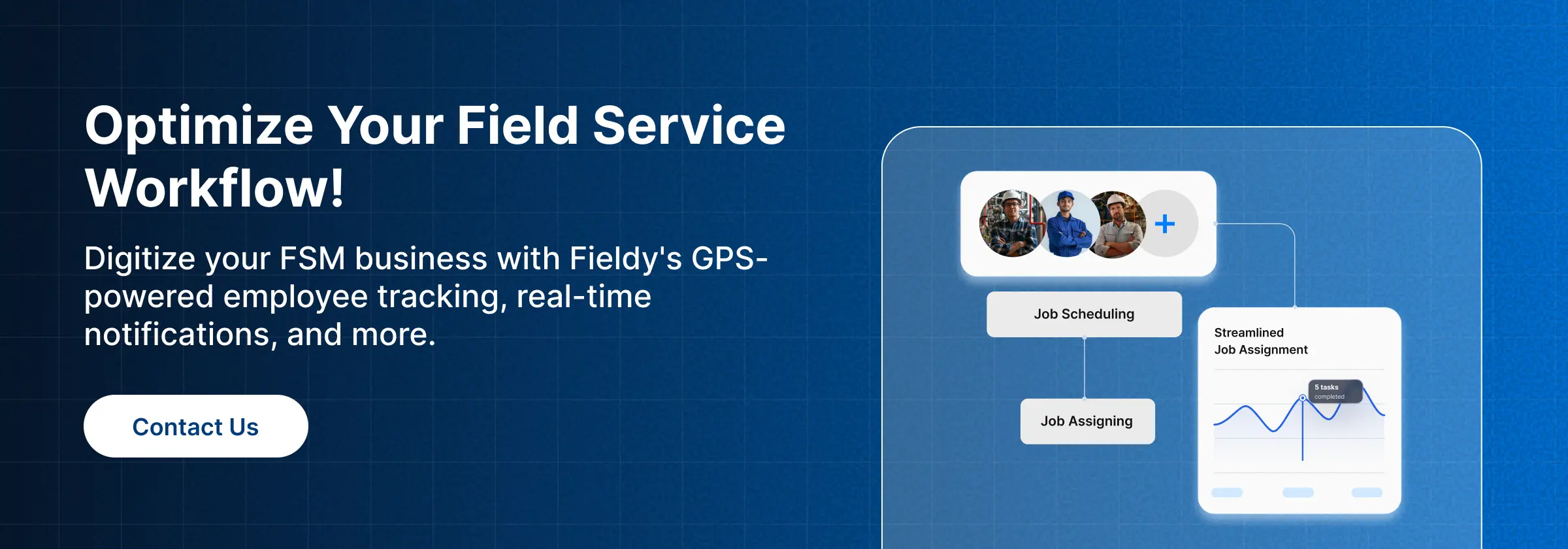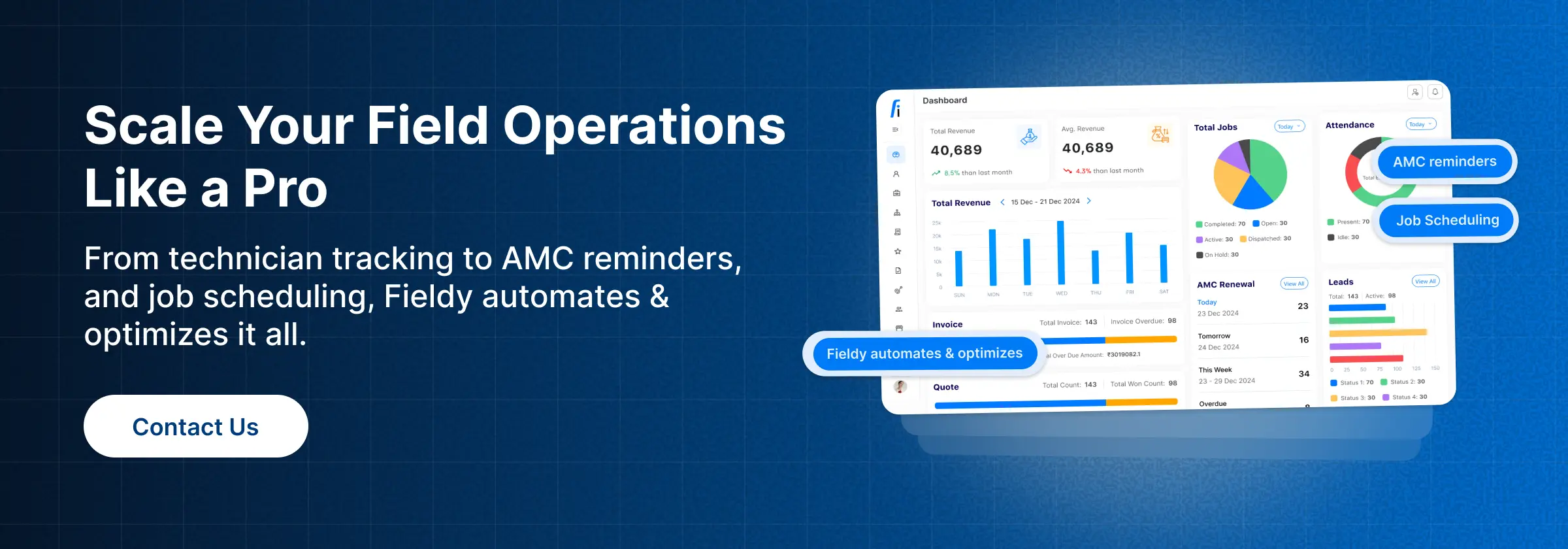👋 Introduction
Efficient scheduling and dispatching of HVAC is one of the critical factors for the growing service-based HVAC in 2025. Due to high customer expectations on the increase fuel and labor prices, and smooth operations, technician assignment, job routing, and prioritization of services are taken as givens. Companies with manual scheduling often suffer from double bookings, delayed dispatch, and missed maintenance appointments, affecting customer satisfaction and bottom-line profitability.
Modern HVAC scheduling and dispatching software solve these issues by automatically assigning jobs, optimizing routes, and binding their services with financial platforms such as QuickBooks to eliminate errors, improve cash flow, and make the service operation more efficient. As such, these systems are seen increasingly as the foundation of an HVAC Field Service Management Software solution that provides both operational control and financial accuracy.
Customers have changed their demeanors toward service expectations. According to a 2024 ServiceTitan study, 68% of homeowners expect same-day service in emergencies affecting urgent HVAC issues, and firms not meeting such expectations stand to lose their repeat customers. Rising operational costs require companies to optimize routing and scheduling with the idea of keeping their profit margins sane: fuel, technician labor, and vehicle maintenance.
🌍 Why HVAC Scheduling and Dispatching Matters in 2025
💸 Revenue Losses from Delays
Poor scheduling and dispatching often lead to cancellations or missed appointments. These disruptions not only frustrate customers but also delay the billing cycle, directly affecting cash flow and overall profitability. HVAC businesses can lose thousands annually due to these inefficiencies if not addressed.
🧾 QuickBooks Integration for Accurate Invoicing
Integrating HVAC scheduling and dispatching software with QuickBooks allows automatic generation of invoices once a job is completed. This ensures that billing is timely, accurate, and tied to job-level costs, reducing administrative errors and improving financial transparency.
👷 Improved Technician Utilization
Assigning jobs strategically based on technician skills, location, and availability ensures maximum productivity. Technicians can complete more jobs per day without working additional hours, improving service coverage while controlling labor costs.
📊 Efficiency Through Modern Field Service Scheduling Software
Modern HVAC Field Service Scheduling Software combines intelligent operational planning with real-time data insights. Managers can monitor job progress, reassign tasks dynamically, and respond to urgent service requests, ensuring that both technician performance and customer satisfaction remain high.
⚠️ Challenges HVAC Businesses Face Without Scheduling & Dispatching Software
Despite its importance, many HVAC businesses still rely on manual methods for assigning work, which introduces several challenges:
| 🚧 Challenge | 📋 Explanation |
|---|---|
| 📅 Missed or Delayed Service Calls | Paper-based scheduling or uncoordinated job assignment often leads to missed appointments, frustrated customers, and lost revenue. |
| 🛣️ Inefficient Routing | Without GPS or AI-based route optimization, technicians may travel extra miles, wasting fuel and increasing operational costs. |
| 👥 Limited Visibility into Technician Availability | Dispatchers can struggle to identify which technicians are free, on-site, or delayed, creating confusion in high-demand periods. |
| 🚨 Difficulty Managing Emergency Requests | Manual scheduling systems make it hard to reprioritize jobs effectively when urgent calls come in, impacting customer satisfaction. |
Integrating Field Service Job Scheduling Software into operations ensures that these inefficiencies are minimized, enabling teams to track workloads, assign technicians intelligently, and respond dynamically to emergencies.
In addition, improved scheduling feeds directly into financial management, aligning operational activities with billing and payroll for consistent job-level profitability, while also supporting strategies on how to get HVAC leads by ensuring timely, reliable service that strengthens customer trust.
🛠️ Features of the Best HVAC Scheduling Software
📅 1. Automated Job Scheduling
Automated scheduling is the foundation of modern HVAC scheduling and dispatching. By automatically assigning the right technician to the right job, businesses eliminate double-bookings and reduce delays.
This also ensures that technicians with the necessary skills are allocated to tasks requiring specialized expertise, improving first-time fix rates.
For HVAC companies, automated scheduling integrates seamlessly with other tools, creating a cohesive workflow where dispatch, service tracking, and invoicing work together. Smart scheduling also improves Field Service Job Scheduling Software efficiency by reducing human errors and freeing managers from micromanaging daily assignments.
🚐 2. Smart Dispatching & Route Optimization
Intelligent dispatching goes beyond simple job assignment. By leveraging GPS and AI-driven route optimization, scheduling software identifies the nearest available technician, minimizing travel time and fuel costs. According to Fleet Advantage, HVAC companies that implemented field service dispatching software route optimization saw an average 15% reduction in travel-related expenses annually.
Efficient dispatching also improves on-time arrival rates, which directly affects customer satisfaction scores. Teams can better manage emergency calls without disrupting other scheduled jobs, ensuring smoother operations throughout the day. Smart dispatching is particularly valuable for residential services, where same-day or emergency visits are common.
🛰️ 3. Real-Time Technician Tracking
Visibility into field operations is crucial for efficiency. Real-time field staff tracking software allows dispatchers to monitor which technicians are available, en route, or delayed. This enables faster response to urgent service requests and helps managers adjust assignments dynamically.
A mid-sized HVAC company in Chicago reported a 20% improvement in emergency response times after implementing real-time tracking within their scheduling software. These insights also help with workload balancing, ensuring technicians aren’t overbooked and service quality remains high. Such monitoring aligns with Employee Productivity Tracking Software, providing actionable data on time spent per job and overall team performance.
🔗 4. Integration with Invoicing & QuickBooks
One of the most significant advantages of modern HVAC scheduling and dispatching software is its seamless integration with QuickBooks. When a job is completed, invoices are automatically generated and synced with QuickBooks Online or Desktop, eliminating duplicate data entry and reducing billing errors.
For example, a mid-sized HVAC contractor in Texas reported reducing invoice processing time by 40% after integrating QuickBooks with their scheduling software. This integration not only improves cash flow but also ensures accurate job costing, making it easier to analyze profitability at a granular level.
📱 5. Mobile App Access
Mobile accessibility allows technicians to update job status, access customer history, and close tickets on-site. This capability improves the first-time fix rate, reduces follow-up visits, and enhances overall service efficiency. Integration with AMC Management Software ensures that preventive maintenance contracts are updated automatically, keeping recurring revenue streams consistent and reliable.
Technicians can also communicate directly with dispatchers through the field service management mobile app, providing real-time updates on job progress or material needs, which enhances operational visibility and responsiveness.
🏆 Best HVAC Scheduling & Dispatching Software for 2025
1️⃣ Fieldy
An all-in-one solution combining scheduling, dispatching, AMC management, and QuickBooks integration. Fieldy’s advanced Field Service Scheduling features reduce missed appointments and improve technician efficiency. A mid-sized HVAC company in Texas saved $60,000 annually by using Fieldy to streamline dispatch, inventory, and invoicing.
2️⃣ FieldEdge
Designed for established HVAC businesses, FieldEdge provides strong QuickBooks integration and reliable scheduling tools for multi-location operations.
3️⃣ ServiceTitan
Enterprise-grade solution for large HVAC teams, offering advanced scheduling, reporting, and dispatching features. A California-based HVAC contractor with 200 technicians reported a 30% improvement in workforce productivity using ServiceTitan combined with QuickBooks. Check out whether Fieldy or ServiceTitan, which FSM software has the edge in 2025.
4️⃣ Housecall Pro
Ideal for residential HVAC businesses, offering mobile-first dispatching and scheduling. A Chicago HVAC startup grew from 2 to 10 technicians in under two years, citing faster invoicing and improved customer communication as key factors. Check out which software delivers in 2025: Fieldy or Housecall Pro.
5️⃣ Arrivy
Automation-focused software providing real-time scheduling, route optimization, and job-to-invoice workflows. Integration with AMC Management Software ensures preventive maintenance contracts are handled efficiently. A Florida HVAC company reduced travel costs by 15% annually using Arrivy’s optimized routes.
These tools also often act as Field Service CRM Software, allowing teams to manage customer relationships, service history, and communication within the same platform.
🎯 Benefits of Using HVAC Scheduling and Dispatching Software
⏩ Faster Response Times
Improved customer satisfaction: Automated HVAC scheduling and dispatching tools ensure technicians reach customers promptly, reducing wait times. Studies show that businesses implementing smart dispatch systems experience a 25–30% drop in customer complaints and a 20% increase in repeat service calls, highlighting the direct impact on loyalty and retention.
⛽ Reduced Fuel and Labor Costs
Optimized routing and strategic technician allocation minimize unnecessary travel, reducing fuel consumption and overtime expenses. According to Fleet Advantage, companies using route-optimization software saved up to 15% annually on fuel costs, while reducing technician idle time by 18%.
📈 Higher Technician Productivity
Real-time scheduling ensures technicians spend more time completing jobs rather than waiting or traveling inefficiently. Businesses report a 12–20% increase in daily jobs completed after adopting automated scheduling tools, translating into higher revenue without increasing headcount.
👀 Real-Time Visibility into Operations
Managers gain live insights into technician location, job progress, and workload. This helps in balancing assignments, responding to emergencies promptly, and identifying performance gaps. Companies using analytics dashboards saw a 30% improvement in dispatch efficiency and better resource utilization across all service teams.
💵 Integrated Financial Tracking with QuickBooks
By connecting scheduling and field operations directly to QuickBooks, businesses can automatically generate invoices, track costs per job, and maintain accurate records. This reduces administrative errors by up to 35% and allows precise job-level profitability analysis, ensuring both operational efficiency and financial control.
🤝 Strengthened Customer Relationships
Timely service, accurate invoicing, and proactive maintenance through recurring contracts and AMC management improve customer trust. HVAC companies leveraging integrated scheduling and QuickBooks systems report an average 15% boost in customer retention over a 12-month period.
🔑 Best Practices for HVAC Scheduling & Dispatching in 2025
🔮 Implement Predictive Maintenance Scheduling
Anticipating service needs before equipment failures occur reduces downtime and emergency calls. Predictive scheduling allows HVAC businesses to plan technician workloads efficiently while keeping customers satisfied with proactive maintenance.
📲 Train Dispatchers & Technicians on Mobile FSM Tools
Ensuring your team is proficient with mobile field service management apps enables accurate, real-time updates. This improves communication, reduces errors in job status reporting, and allows managers to adjust assignments dynamically.
📊 Use Analytics Dashboards to Optimize Workloads
Data-driven insights help identify overbooked or underutilized technicians, prevent burnout, and balance assignments based on skill, location, and availability. Leveraging analytics also highlights patterns for peak seasons and high-demand service areas.
🔄 Automate Follow-Ups, Recurring Schedules & AMCs
Automation ensures that preventive maintenance, contract renewals, and recurring service appointments happen on time, maintaining consistent revenue streams and strengthening customer relationships.
🛣️ Regularly Review Routes & Scheduling Efficiency
Continuous evaluation of routes, job assignments, and technician performance ensures that operational processes adapt to business growth, seasonal demand, and evolving customer expectations, keeping both efficiency and profitability high.
✅ Conclusion
In 2025, HVAC scheduling and dispatching software is no longer a luxury, it is essential for operational efficiency, cost control, and customer satisfaction. Companies that adopt modern tools can streamline technician assignments, reduce travel and labor costs, improve cash flow, and enhance service quality.
Solutions like Fieldy exemplify how all-in-one scheduling, dispatching, and QuickBooks integration can transform HVAC operations, helping businesses scale efficiently while maintaining high levels of customer satisfaction. Modern HVAC businesses that leverage these systems gain a competitive edge in both operational performance and financial management.
❓FAQs
What is HVAC scheduling and dispatching software?
It is software that automates job assignments, optimizes routes, and tracks technicians in real-time to improve efficiency and ensure accurate invoicing. It also helps managers monitor workload and performance across all field teams.
Why is HVAC dispatching important in 2025?
Smart dispatching ensures timely service, optimizes resource use, reduces operational costs, and improves customer satisfaction. It enables businesses to handle emergency requests without disrupting regular schedules.
Which is the best HVAC scheduling software?
Fieldy is ideal for all-in-one solutions, ServiceTitan works well for large enterprises, Housecall Pro suits residential HVAC, and Arrivy is strong for automated, modern workflows. The right choice depends on company size, job volume, and workflow needs.
How does QuickBooks integration help?
It automates invoicing, reduces errors, and provides accurate job-level financial tracking, aligning field operations with accounting systems. Integration ensures smoother billing cycles and better job profitability visibility.
What features should I look for in HVAC scheduling software?
Key features include automated job scheduling, smart dispatching, route optimization, real-time technician tracking, mobile access, and AMC management. These features together improve efficiency, reduce errors, and enhance customer service.
How does HVAC scheduling software improve productivity?
Reducing idle time, optimizing routes, and efficient assignments boost daily job completion and let managers track performance in real-time.




